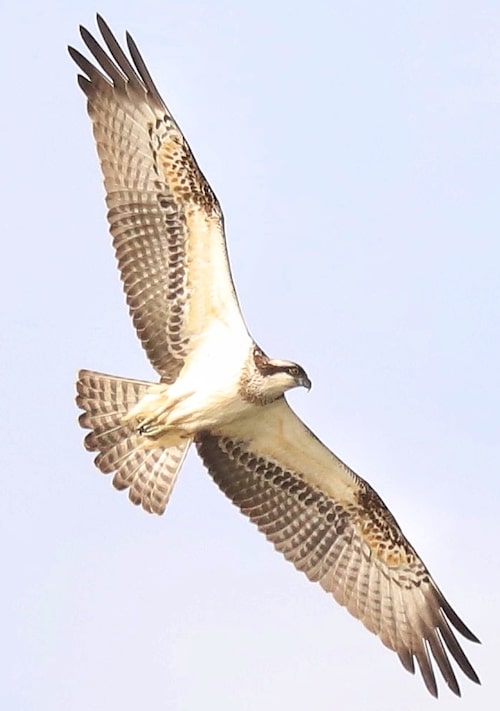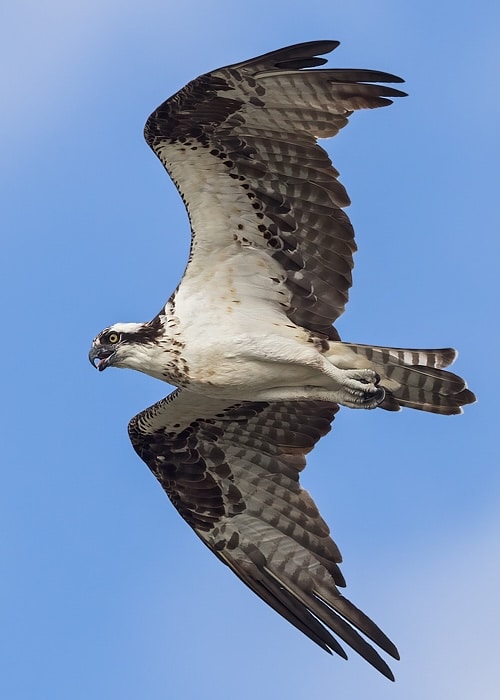Pandionidae – Ospreys

The Pandionidae or Osprey family has recently been revised and the former lone species split into two species which are virtually identical but inhabit different areas of the world. They are also called fish eagles, sea hawks, river hawks, and fish hawks. Ospreys are a diurnal, fish-eating bird of prey with a cosmopolitan range and are large raptors, reaching more than 60cm in length and 180cm in wingspan.
They have brown on the upper parts and are predominantly greyish on the head and underparts, which can look white to the naked eye. They tolerate a wide variety of habitats, nesting in any location near a body of water that provides an adequate food supply. Ospreys are found on all continents except Antarctica, although in South America only as a non-breeding migrant.

Western Osprey Pandion halieatus – ©Dubi Shapiro
As the other common names suggest, the ospreys’ diet consists almost exclusively of fish. They possess specialised physical characteristics and exhibit unique behaviour to assist in hunting and catching prey. As a result of these unique characteristics, they have their own taxonomic genus – Pandion and family – Pandionidae. Four subspecies were formerly recognised, but one has recently been given full species status as Eastern Osprey which is found on the rivers and coastlines of Australia. Despite their propensity to nest near water, ospreys are not classed as sea eagles.
-
Number of bird species: 2
Western Osprey Pandion haliaetus
Eastern Osprey Pandion cristatus
-
Dyfi Osprey Project
WebsiteThe Dyfi Osprey Project has been running at Cors Dyfi Nature Reserve near Machynlleth since 2009. Find out more about the work and history of the Dyfi Osprey Project here. -
International Osprey Foundation
WebsiteThe International Osprey Foundation, Inc., a non-profit corporation, is dedicated to the continuing recovery and preservation of the osprey, others in the raptor family, wildlife and the environment as a whole. The Foundation conducts monitoring activities, and accumulates data specific to the breeding activities of the osprey population. The data is made available through the Foundations newsletter publication and can be obtained by interested parties/organizations upon request. The Foundation issues grants for researchers whose studies involve environmental concerns. The Foundation directs and participates in all areas of wildlife and habitat maintenance and restoration. -
Osprey Project [UK]
InformationWe’ve been fighting to protect endangered species since 1889. Species under threat & the issues facing them may differ, but the need to help wildlife is urgent. -
Rutland Water Osprey Project
InformationRutland Water is home to the first Ospreys to breed in England for 150 years, after a translocation programme. We observe them from their arrival from Africa in spring, through to their autumn migration. Come and join us at Rutland Water Nature Reserve to learn more about these magnificent birds!
-
Inside an Osprey's Nest - A Photographic Journey Through Nesting Season
| By Teena Ruark Gorrow & Craig A Koppie | Schiffer | 2016 | Hardback | 144 pages, 380 colour photos | ISBN: 9780764352003 Buy this book from NHBS.com -
Lady of the Loch
| The Incredible Story of Britain's Oldest Osprey | By Helen Armitage | 2011 | Constable | Paperback | 177n Pages, Mao | ISBN: 9781849017022 Buy this book from NHBS.com -
Ospreys - The Revival of a Global Raptor
| By Alan F Poole | Johns Hopkins University Press | 2019 | Hardback | 205 pages, 122 colour photos, 4 colour illustrations, 20 colour maps | ISBN: 9781421427157 Buy this book from NHBS.com -
RSPB Spotlight: Osprey
| By Tim Mackrill | Bloomsbury Publishing | 2019 | Paperback | 128 Pages | colour photos| ISBN: 9781472956033 Buy this book from NHBS.com -
The Osprey
| By Tim Mackrill | A & C Black | 2024 | Flexibound | 304 pages, 150 colour photos, colour illustrations, and colour maps; colour tables | ISBN: 9781472992611 Buy this book from NHBS.com -
The Rutland Water Ospreys
| By Tim Mackrill | A & C Black | 2013 | Hardback | 160 pages | 200+ colour photos | 200+ colour & black & white illustrations | Out of Print | ISBN: 9781408174142 Buy this book from NHBS.com
-
Eastern Osprey Pandion cristatus
Species AccountSound archive and distribution map. -
Western Osprey Pandion haliaetus
Species AccountThe osprey (Pandion haliaetus) — also called fish eagle, sea hawk, river hawk, and fish hawk — is a diurnal, fish-eating bird of prey with a cosmopolitan range. It is a large raptor, reaching more than 60 cm (24 in) in length and 180 cm (71 in) across the wings. It is brown on the upperparts and predominantly greyish on the head and underparts. -
Western Osprey Pandion haliaetus
Cornell Species AccountUnique among North American raptors for its diet of live fish and ability to dive into water to catch them, Ospreys are common sights soaring over shorelines, patrolling waterways, and standing on their huge stick nests, white heads gleaming. -
Western Osprey Pandion haliaetus
IUCN Species Status -
Western Osprey Pandion haliaetus
RSPB Species AccountWhen seen in flight from below, the Osprey has white or slightly mottled underparts. The wings are angled, bending at the 'wrist' (middle) which has a black patch contrasting with the white wing linings and, at a distance, it could be mistaken for a large gull. This spectacular fish-eating bird of prey is an Amber List species because of its historical decline (due to illegal killing) and low breeding numbers. They are listed as a Schedule 1 species on The Wildlife and Countryside Act. -
Western Osprey Pandion haliaetus
Species AccountSound archive and distribution map.
